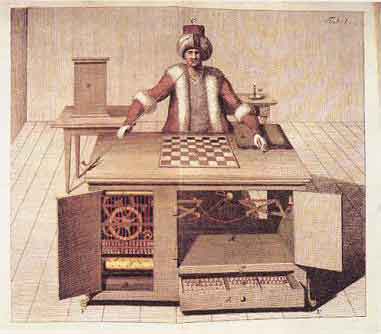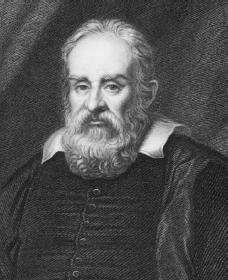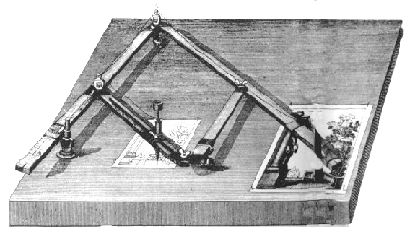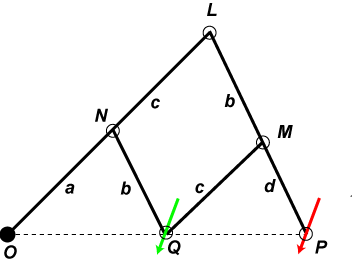|
1. THE PANTOGRAPH
|
||
|
The Inventor
We remember Scheiner for constructing the first pantograph in 1603, and writing about it in some detail in 1631 in his work Pantographice. He used the device to duplicate or enlarge diagrams. In spite of this, it is generally believed that the great Leonardo da Vinci (1452 – 1519) used one musch earlier!
Following Leonardo da Vinci’s lead, later pantographs were adapted for duplicating paintings. First the pantograph would be used to trace the outlines, and then the shapes would be filled with paint. Sculptors and carvers adapted the pantograph for tracing master drawings onto blocks of marble or wood. In the 18th century the pantograph was used to cut out the typeset letters for printing and engravings. In the 19th century, advanced pantographs were even used to duplicate sculptures, like Michelangelo’s David. Heavy-duty pantographs are still used for engraving and contour milling. These days, enlargement of diagrams is much more easily done with the help of a photocopier.
In 1804, Thomas Jefferson first acquired the letter-copying device he called ‘the finest invention of the present age’. This so-called ‘polygraph’ was invented by English-born John Isaac Hawkins. It was based on the principles of the pantograph, and had two or more pens that were moved simultaneously by the writer's hand, making a duplicate copy or copies strikingly like the original.
 A rather humorous innovation in the history of the pantograph was ‘The Turk’ – an automaton that could play chess. This took place long ago in 1769 when it seemed impossible to have an automaton that could play chess. The Turk went on to beat many people and became famous. It turned out that there was actually a person inside the base of the automaton that played the games of chess. This person’s arm was linked to the Turk’s arm by a pantograph-like structure. You might like to look up A rather humorous innovation in the history of the pantograph was ‘The Turk’ – an automaton that could play chess. This took place long ago in 1769 when it seemed impossible to have an automaton that could play chess. The Turk went on to beat many people and became famous. It turned out that there was actually a person inside the base of the automaton that played the games of chess. This person’s arm was linked to the Turk’s arm by a pantograph-like structure. You might like to look up
http://www.museumofhoaxes.com/hoax/
The figure at right shows the basic design of the pantograph. Point O is fixed, all struts have constant length, the structure pivots at L, M, N, a pointer at Q traces over the shape being enlarged, and the pen at P reproduces the shape on a larger scale. Figure LMQN is a parallelogram. It is important that points O, P, Q be collinear. If you were making a model, you might find it easier to place pointer Q away from the pivot. In this case you would need to adjust the position of P to retain the collinearity of points O, P, Q. Is it obvious that points O, Q, P in the figure will remain collinear as the structure moves? Well, yes, since triangles ONQ, OLP are always similar (S.A.S. similarity test, using ON : OL, NQ : LP and included angles). Hence angles NOQ and LOP are equal, and the result follows. We easily see that the pantograph produces a mathematical enlargement. For by similar triangles ONQ, OLP, OQ : OP = ON : OL = a : a + c which is constant. Thus for example, if c = a the pantograph would double the size of the original figure.
|
||
|
|
 The Jesuit astronomer Christoph Scheiner (1575 – 1650) was born in Swabia and died in Silesia. He was a physicist and astronomer, and is remembered as one of the pioneers in the observation of sunspots. There was some unpleasant controversy with Galileo over the nature of sunspots and priority of their discovery.
The Jesuit astronomer Christoph Scheiner (1575 – 1650) was born in Swabia and died in Silesia. He was a physicist and astronomer, and is remembered as one of the pioneers in the observation of sunspots. There was some unpleasant controversy with Galileo over the nature of sunspots and priority of their discovery.
 The Mathematics
The Mathematics